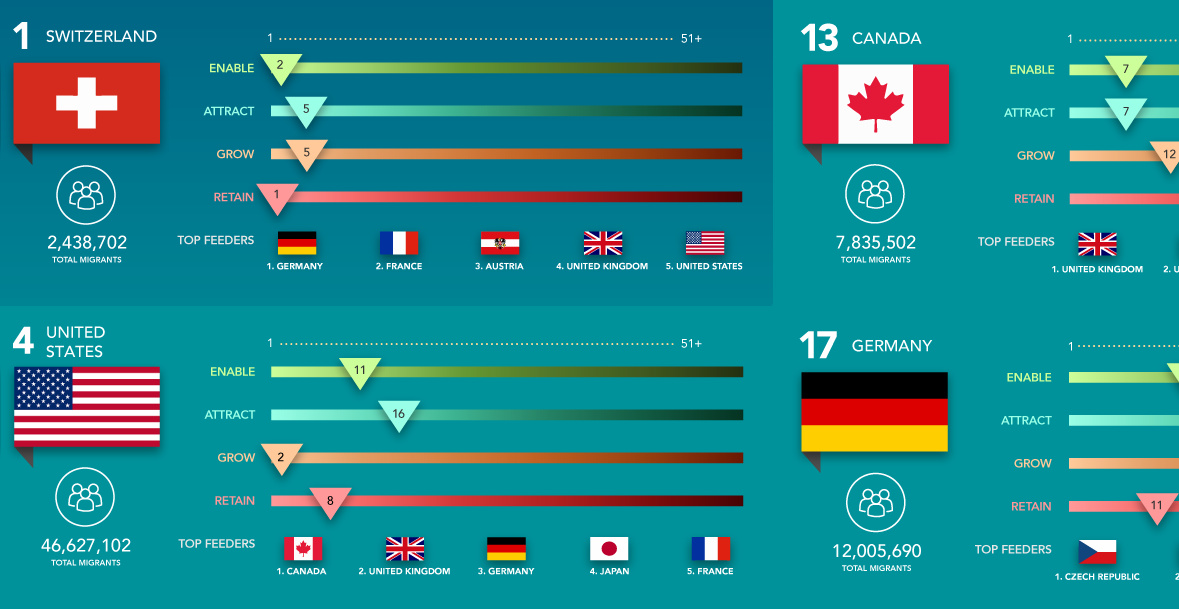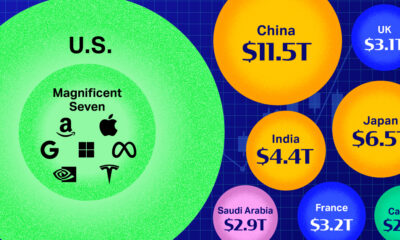Technology
Which Countries Are Set to Attract the Highest Skilled Workers from Abroad?
For the world’s most innovative companies, the stated goal of attracting top talent is not simply an HR mantra – it’s a matter of survival.
Whether we’re talking about a giant like Google that is constantly searching to add world-class engineers or we’re talking about a startup that needs a visionary to shape products of the future, innovative companies require access to high-skilled workers to stay ahead of their competition.
The Global Search for Talent
There’s no doubt that top companies will go out of their way to bring in highly-skilled workers, even if they must look internationally to find the best of the best.
However, part of this recruitment process is not necessarily under their control. The reality is that countries themselves have different policies that affect how easy it is to attract people, educate and develop them, and retain the best workers – and these factors can either empower or undermine talent recruitment efforts.
Today’s infographic comes from KDM Engineering, and it breaks down the top 25 countries in attracting high-skilled workers.

If attracting the best people isn’t hard enough, there is another factor that can complicate things: the best people are sometimes not found locally or even nationally.
For top companies, recruitment is a global game – and it’s partially driven by the policies of governments as well as the quality of life within their countries’ borders.
Top Countries for Attracting High-Skilled Workers
Using data from the United Nations and the Global Talent Competitive Index, here are the top 10 countries that are the best at attracting and retaining highly-skilled workers.
They are ordered by overall rank, but their sub-category ranks are also displayed:
| Overall Rank | Country | Enable | Attract | Grow | Retain | Migrants |
|---|---|---|---|---|---|---|
| #1 | 🇨🇭 Switzerland | #2 | #5 | #5 | #1 | 2,438,702 |
| #2 | 🇸🇬 Singapore | #1 | #1 | #13 | #7 | 2,543,638 |
| #3 | 🇬🇧 United Kingdom | #8 | #11 | #7 | #5 | 8,543,120 |
| #4 | 🇺🇸 United States | #11 | #16 | #2 | #8 | 46,627,102 |
| #5 | 🇸🇪 Sweden | #9 | #13 | #8 | #4 | 1,639,771 |
| #6 | 🇦🇺 Australia | #17 | #6 | #9 | #14 | 6,763,663 |
| #7 | 🇱🇺 Luxembourg | #21 | #2 | #17 | #3 | 249,325 |
| #8 | 🇩🇰 Denmark | #3 | #15 | #3 | #15 | 572,520 |
| #9 | 🇫🇮 Finland | #6 | #21 | #4 | #9 | 315,881 |
| #10 | 🇳🇴 Norway | #13 | #14 | #10 | #2 | 741,813 |
The subcategory ranks are defined as follows:
- Enable: Status of regulatory and market landscapes in country
- Attract: Ability to attract companies and people with needed competencies
- Grow: Ability to offer high-quality education, apprenticeships, and training
- Retain: Indicates quality of life in country
According to the data, Switzerland (#1) and Singapore (#2) are the two best countries for attaining and keeping high-skilled workers.
While the regulatory environments in both of these countries are well-known by reputation, perhaps what’s more surprising is that Singapore scores the #1 rank in the “Attract” subcategory, while Switzerland is the #1 country for retaining talent based on quality of life.
Another data point that stands out?
The United States has a higher total migrant population (46.6 million) than all of the countries on the top 10 list combined. Not surprisingly, the massive U.S. economy also has a high ranking in the “Grow” category, which represents available opportunities to bring high-skilled workers to the next level through education and training.
Technology
Ranked: Semiconductor Companies by Industry Revenue Share
Nvidia is coming for Intel’s crown. Samsung is losing ground. AI is transforming the space. We break down revenue for semiconductor companies.
Semiconductor Companies by Industry Revenue Share
This was originally posted on our Voronoi app. Download the app for free on Apple or Android and discover incredible data-driven charts from a variety of trusted sources.
Did you know that some computer chips are now retailing for the price of a new BMW?
As computers invade nearly every sphere of life, so too have the chips that power them, raising the revenues of the businesses dedicated to designing them.
But how did various chipmakers measure against each other last year?
We rank the biggest semiconductor companies by their percentage share of the industry’s revenues in 2023, using data from Omdia research.
Which Chip Company Made the Most Money in 2023?
Market leader and industry-defining veteran Intel still holds the crown for the most revenue in the sector, crossing $50 billion in 2023, or 10% of the broader industry’s topline.
All is not well at Intel, however, with the company’s stock price down over 20% year-to-date after it revealed billion-dollar losses in its foundry business.
| Rank | Company | 2023 Revenue | % of Industry Revenue |
|---|---|---|---|
| 1 | Intel | $51B | 9.4% |
| 2 | NVIDIA | $49B | 9.0% |
| 3 | Samsung Electronics | $44B | 8.1% |
| 4 | Qualcomm | $31B | 5.7% |
| 5 | Broadcom | $28B | 5.2% |
| 6 | SK Hynix | $24B | 4.4% |
| 7 | AMD | $22B | 4.1% |
| 8 | Apple | $19B | 3.4% |
| 9 | Infineon Tech | $17B | 3.2% |
| 10 | STMicroelectronics | $17B | 3.2% |
| 11 | Texas Instruments | $17B | 3.1% |
| 12 | Micron Technology | $16B | 2.9% |
| 13 | MediaTek | $14B | 2.6% |
| 14 | NXP | $13B | 2.4% |
| 15 | Analog Devices | $12B | 2.2% |
| 16 | Renesas Electronics Corporation | $11B | 1.9% |
| 17 | Sony Semiconductor Solutions Corporation | $10B | 1.9% |
| 18 | Microchip Technology | $8B | 1.5% |
| 19 | Onsemi | $8B | 1.4% |
| 20 | KIOXIA Corporation | $7B | 1.3% |
| N/A | Others | $126B | 23.2% |
| N/A | Total | $545B | 100% |
Note: Figures are rounded. Totals and percentages may not sum to 100.
Meanwhile, Nvidia is very close to overtaking Intel, after declaring $49 billion of topline revenue for 2023. This is more than double its 2022 revenue ($21 billion), increasing its share of industry revenues to 9%.
Nvidia’s meteoric rise has gotten a huge thumbs-up from investors. It became a trillion dollar stock last year, and broke the single-day gain record for market capitalization this year.
Other chipmakers haven’t been as successful. Out of the top 20 semiconductor companies by revenue, 12 did not match their 2022 revenues, including big names like Intel, Samsung, and AMD.
The Many Different Types of Chipmakers
All of these companies may belong to the same industry, but they don’t focus on the same niche.
According to Investopedia, there are four major types of chips, depending on their functionality: microprocessors, memory chips, standard chips, and complex systems on a chip.
Nvidia’s core business was once GPUs for computers (graphics processing units), but in recent years this has drastically shifted towards microprocessors for analytics and AI.
These specialized chips seem to be where the majority of growth is occurring within the sector. For example, companies that are largely in the memory segment—Samsung, SK Hynix, and Micron Technology—saw peak revenues in the mid-2010s.
-

 Real Estate2 weeks ago
Real Estate2 weeks agoVisualizing America’s Shortage of Affordable Homes
-

 Technology1 week ago
Technology1 week agoRanked: Semiconductor Companies by Industry Revenue Share
-

 Money1 week ago
Money1 week agoWhich States Have the Highest Minimum Wage in America?
-

 Real Estate1 week ago
Real Estate1 week agoRanked: The Most Valuable Housing Markets in America
-

 Business2 weeks ago
Business2 weeks agoCharted: Big Four Market Share by S&P 500 Audits
-

 AI2 weeks ago
AI2 weeks agoThe Stock Performance of U.S. Chipmakers So Far in 2024
-

 Misc2 weeks ago
Misc2 weeks agoAlmost Every EV Stock is Down After Q1 2024
-

 Money2 weeks ago
Money2 weeks agoWhere Does One U.S. Tax Dollar Go?














